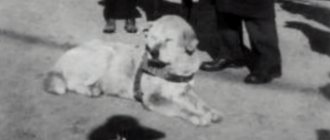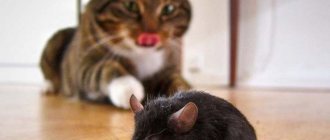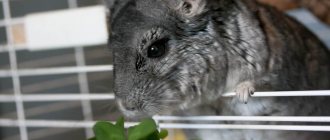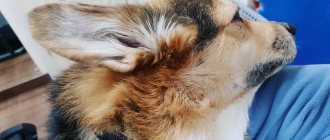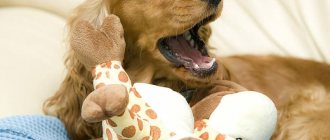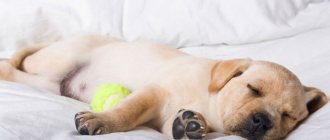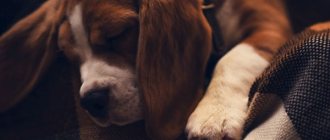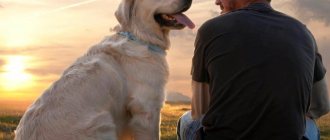The scientific description of a dog is a generalized description of all placental mammals of the order of carnivores from the canine family. Kingdom – animals, phylum – chordates.
This description includes both domestic and stray animals, since both groups have identical “roots” - ancient wolf-like and ancient jackal-like.
Domestic dogs differ from their “wild” counterparts in a number of ways:
- their reproduction is controlled by people;
- they are bred to satisfy human needs;
- they are differentiated into breeds.
Scientific description of the dog: origin
Scientists have differing opinions about the origin of dogs. Some believe that these domestic animals appeared as a result of natural crossing of several species of wild mammals; accordingly, they belong to a polyphyletic group.
Others believe that they appeared as a result of the evolution of one particular species of wild animals and belong to a monophyletic group.
The first domesticated dogs appeared about 14,000 years ago. There is a high probability that in fact the domestication of a wild animal occurred earlier, but this information has not reached our time.
In turn, the oldest breed today is considered to be the Pharaoh Hound, which appeared about 5,000 years ago.
In the process of evolution, the domestic animal has lost some “wild” characteristics, acquiring new ones in return. The number of species expanded, ultimately leading to the fact that there are currently about 400 dog breeds in the world.
Dog breeding
A dog's pregnancy lasts from 58 to 62 days. At the same time, from one to ten and even fifteen viable puppies can be born, which the mother feeds with milk. The suckling period in dogs lasts up to 8 weeks, but at about 4-5 weeks, puppies are able to feed on their own.
The average lifespan of dogs is 8-15 years. Although there are frequent cases where dogs lived to an older age - 19 - 21 years.
Physiological parameters, skeleton
Weight and height
It is better to talk about variations in height and weight of these mammals in numbers. So, today the smallest individual is considered to be the Chihuahua breed, whose minimum height is 15 cm and weight is no more than 2 kg.
The tallest dog is the Great Dane, the maximum height of individual representatives reaches 111 cm. The heaviest is the Pyrenean Mastiff, weighing more than 100 kg.
Voice
Various types of barking (low, high) or replacing them with howls and squeals are considered the norm. In some cases, a complete absence of barking is acceptable, if this is provided for by the breed (for example, like the Basenji).
Ears
Dogs have different ear shapes and different positions of the auricle. There are:
- High set, low set ears;
- erect, hanging, semi-erect, semi-dropping ears.
An important digression in a brief scientific description of the dog: in order for the animal to begin to meet FCI standards, some breeders and owners resort to docking, this allows them to artificially correct the shape of the ears.
Teeth
All representatives of such an animal have two sets of teeth: milk and molars. The first ones are usually replaced by the second ones by the 5th month of the puppy’s life.
Well-developed canines, pre-root and root teeth allow the placental mammal to easily consume food of animal origin, and small front incisors - food of plant origin.
Fingers and claws
Dogs have 5 toes on their front paws and 4 on their hind paws (some individuals also have 5 toes on their hind paws). The claws are hard, non-retractable, blunt, and predominantly dark in color.
Tail
The tail has a special role, since it is an indicator of the working qualities of the animal and its psychological state.
Color
The color of the animal directly depends on the so-called “pigment granules”, which are responsible for the blue-black, brown, yellow and orange colors.
The fewer black granules, the lighter the coat. If there are no yellow pigment granules in the dog's hair, then the individual gets a gray, silver or blue color.
At the same time, yellow and/or black hair is prevalent in the coat of almost all breeds; this is another “reminder” of the kinship between dogs and wolves.
Mention should be made of the rare albino dogs. They are carriers of absolute white fur and red eyes.
In turn, the structure of animal hair is also diverse; there are four main groups:
- straight;
- curly;
- twisted;
- curly.
In addition, the coat can be short, long, combined, silky and hard. For certain breeds, for example, the Mexican Hairless Dog, the norm is almost complete absence of hair.
Behavior and psychology
The main feature of the dog is its ability to quickly switch between sleep and wakefulness, while the animal is equally active during the day and at night.
The second unique quality of this predatory mammal is the ability to distinguish speech intonation, gestures and the mood of a person. However, such a skill is fully revealed only if the animal is in continuous contact with people for a long time.
The speed of remembering service commands depends on the breed and the degree of trust in the owner. Any dog can be trained if you start training it from puppyhood.
Habitat and life expectancy
Under normal conditions of detention (good nutrition, sufficient physical activity, vaccination and timely provision of veterinary care), the life expectancy of an animal can reach 16 years.
An important role in the scientific description of the dog in this case is played by both the breed and the genetic predisposition of the mammal to certain diseases.
The usual habitat is human habitation, however, even in the natural environment, most animals quickly adapt. Moreover, each subsequent offspring, growing up without contact with people, becomes more and more wild.
The main enemies are large predators and people.
Scary times in dog history
There were many scary moments in the dog's history. In some periods of time, these animals were literally exterminated because one class of humans simply hated them.
In 1796, in England, the authorities introduced taxes on street and domestic dogs. Because of this introduced idea, many pet owners were forced to kill their pets.
It is worth noting that there have been cases in history when dogs were treated with respect as sacred animals. The ancient American Toltec tribes sacrificed four-legged pets at funerals. This was done so that the dog would accompany the soul of the deceased to the afterlife.
Hierarchical structure
Dogs have pack behavior, so they simply need a leader or leader for full-fledged life. If an animal does not find a dominant in a human family, it tries to become one in every possible way.
The first signs that signal an attempt to seize power include growling while eating or playing.
An attack on a person occurs only when the individual has finally believed in its own strength. Most often, children fall under such a blow; they are weaker than adults physically and emotionally.
For this reason, teaching a dog basic commands is a necessary measure that should be applied to all dogs without exception. After all, small breeds of dogs are no less dangerous than large breeds.
About dogs for children. Dog breeds for families with children
Probably all children want a dog. And no wonder - after all, a dog can become a child’s best friend for many years, be a partner in everyday children’s games, a protector, a security guard. A loyal, kind, intelligent dog is a constant hero of various films and television series.
Children's best friend
Many parents are quite categorical about having a four-legged friend in the house, especially if we are talking about a small city apartment. In fact, this is a misconception - there are also small breeds of dogs; for children and an apartment they are an excellent combination. So, as you can see, these problems are completely solvable.
Even an allergy to fur or dander will not be a problem - there are many pets that are hypoallergenic and practically do not cause negative symptoms.
While there are so many different breeds to choose from, there are some of the best dog breeds for kids that combine great social skills, kindness, and intelligence. Such a dog will not only become a member of your family, but will also help in raising a child in a certain way.
Below are some dog breeds for families with children:
- The Labrador Retriever is a legendary dog that has a reputation as a reliable and loyal friend with an excellent mind. It is not for nothing that they are chosen as assistants for people with disabilities. Very attached to people, active, energetic and perfect as a dog for an apartment and a child.
- Dalmatian - perhaps everyone knows these dogs, thanks to the Disney cartoon. They love to be with their family, they are responsive, incredibly loyal, and wonderful companions for children. Very active and resilient, they need daily physical activity.
- Welsh Corgis are small four-legged friends, very good-natured, love people, and are intelligent. Despite its small size, it adapts perfectly to any living conditions; it needs various games and interactive entertainment, without which the dog’s character can deteriorate.
- The Collie, or Scottish Sheepdog, is recognized all over the world thanks to the television series Lassie. She has boundless love for her family and children, is very smart and is able to guess the desires of her owner. Despite her good disposition, she is ready to do anything for her family members and can protect a child in a difficult situation.
Reproduction
Here the brief scientific description of the dog should be divided between domestic and stray individuals.
- The reproduction of domestic pets is adjusted by humans using zootechnical techniques.
- Mating of stray animals occurs according to the principle of monocyclicity, that is, dogs can reproduce every six months.
Pregnancy lasts approximately 2 months, immediately after birth the puppies are absolutely helpless. It is for this reason that most females have a highly developed maternal instinct.
Males, on the contrary, have an absolutely calm attitude towards their offspring, and attacks of aggression towards them are not uncommon.
Intelligence, memory and other facts about four-legged animals
Dogs have a level of intelligence that is comparable to a two-year-old child. In addition, animals can remember up to 250 commands and have a number of skills.
Dogs don't like hugs
Biologist and dog handler Alexandra Semenova reports that dogs do not respond well to strong hugs from humans: they perceive this gesture as a sign of dominance. Often, hunting dogs even begin to bark when trying to hug them: the animal is uncomfortable with such contact.
Developed sense of smell and hearing
Dogs' senses are highly heightened. Dogs are able to hear sounds that are inaccessible to the human ear. Animals have a wider range of perception of sound waves. So, unlike people, they are able to hear ultrasound.
Dogs recognize both higher and lower sounds. It is for this reason that animals sense the approach of rain and thunder before people. From a human perspective, dogs often begin to behave strangely for no apparent reason. However, the animal's behavior is reasonable.
Dogs’ sense of smell is also developed many times better than that of a human, thanks to which they often help people as guides, in rescue and secret operations, finding narcotic substances and missing objects.
The emperor's own bodyguard
Pekingese dogs formed the last line of defense for the emperor in Ancient China. In situations where, for one reason or another, the ruler was left without protection and was in danger, the dog, hiding in one of the sleeves of the emperor’s clothes, attacked the offender.
Studded collars are not a tribute to fashion
The spikes located on the collars had a practical purpose. In Ancient Greece, dog owners put them on their pets to prevent them from being killed by wolves. As you know, in the neck of dogs, as well as in many other animals, there are arteries, damage to which can lead to inevitable death.
Secondary feral dog
History is full of funny incidents. Thus, the dingo dog, which is classified as a subspecies of the gray wolf, was domesticated several thousand years ago, and then went wild again. Most of the population of these animals today is located in Australia.
No sweets
Chocolate poses a deadly risk to dogs. The product contains theobromine. The alkaloid can cause disturbances in the functioning of the central nervous system. It also has a negative effect on the myocardium, the main heart muscle. While in the human body this substance is broken down by enzymes, in the body of dogs, as well as cats, it remains unchanged.
Dogs-astronauts
Dogs are not in the kennel all the time. In 1960, dogs named Belka and Strelka set off on a journey beyond the atmosphere. After spending 25 hours in outer space, the animals made 17 full revolutions around the Earth and returned home. This short flight gave rise to a great era, after which man began to rapidly explore space.
Every dog's nose is unique
If you look closely at the animal's nose, you will notice numerous inconsistent patterns on it. This pattern is unique for each dog: no two animals have the same nose print - this is comparable to the fingerprint in humans.
For a long time, paw prints were used for identification. But this method has long gone into oblivion, since a more accurate one was found. Today, every breeder and animal trainer must have an imprint of the nose of their charges - this is a kind of document that is involved in obtaining insurance for the dog, and will also help to find the dog if it gets lost.
Dogs dream
Animals have access to dreams, both good and bad. The sleep process, like in humans, occurs in two phases: fast and slow sleep. On average, the first lasts no more than 5-10 minutes, the second has a longer duration - 45-60 minutes, during which the dog’s brain processes the information received during the day.
It is noteworthy that the duration of sleep phases depends on the size of the dog. Thus, miniature animals have dreams every 10 minutes, however, their duration is short - only about 1 minute. The frequency of dreams is also directly related to age: puppies and older animals see them less often.
How do dogs sweat?
Despite the fact that dogs produce sweat in the same way as humans - mainly during physical activity - the process of thermoregulation occurs differently. Sweat glands in animals are located on the paws. There is a misconception that dogs sweat through their mouth: this is not entirely true. In order to cool their body, dogs actually begin to breathe frequently, thereby partially normalizing the body temperature, but this has nothing to do with the process of sweating.
It is noteworthy that large dogs, such as Alabai and Akita Inu, can cope with overheating more easily than miniature ones. Large dogs happily participate in various competitions, coping well with stress, but, for example, bulldogs and pugs have very difficult breathing - it is much more difficult for representatives of these breeds to maintain a comfortable body temperature.
Hierarchy breeds discipline
Due to the fact that dogs are highly social animals, there must be a hierarchy in interactions with them. So, if you show your pet that the owner is in charge, a kind of leader of the pack, he will treat him with respect and will not dare to disobey. If, on the contrary, in communicating with a dog you do not show qualities that will indicate to it that a person is an authority, it will not behave in a disciplined manner.
The relationship between a four-legged animal and its owner should be built on the encouragement of those animal actions that are acceptable, and on a firm, but at the same time non-violent, lack of encouragement of unacceptable behavior. Under no circumstances should you hit a dog or yell at it, but you should say in a calm, confident and low voice that the dog did something bad if the situation requires it.
The dog will not understand the meaning of the words, but intonation is more important in this matter. When a dog pleases its owner, the person should treat him to delicious food, stroke him, and say in a soft and kind voice that he is doing well. It is also important to note that if a lot of time has passed since the animal did something inappropriate, it is not a good idea to try to discipline it. At best, it will not understand why it is not treated as well as usual; at worst, the dog will gradually begin to develop neurosis.
Functions
Domestic dogs are the best helpers for humans, which, depending on the breed and the work task assigned to them, have performed and continue to perform the following functions:
- security;
- guards;
- wanted;
- rescue;
- auxiliary (guides, healers, companions);
For example, canistherapy is a branch of animal therapy. Its main task is to use dogs for the rehabilitation and treatment of sick people.
- shepherds;
- hunting;
- sledding;
- combat (miners, orderlies);
- starting mechanisms.
The so-called “trochanteric” dogs finally disappeared by the end of the 19th century. Mainly used in England in kitchens to drive spits, various threshers and pumps.
Differences in breeds
Interesting facts about dogs - features of different breeds. The smallest dog was recognized as the Chihuahua, and the largest was the Great Dane, its height at the withers was 109 centimeters and its weight was 111 kilograms. The English mastiff Zorba had the most weight - 155.6 kg, and his height was 94 cm.
If we talk about the color of dogs’ fur, then the whole range of colors is here - the usual dark and light tones, as well as brown and red and a variety of their shades. There are breeds with curls - the poodle, and the xolo (Mexican hairless dog) has traces of hair on the face, and the entire skin is dense, smooth and protects it well from minor injuries and insect bites. What distinguishes this dog from others is the presence of sweat glands throughout the body, and not just on the paws and tongue. A record has been recorded for the longest coat of one of the breeds – 55 cm.
Mexican Xolo breed
Dogs that are harnessed to sleds (huskies, huskies, Samoyeds) are very hardy, for example, six sled dogs can carry 1 ton on a sled, which they can last in a sled for up to 3 hours. Hunting dogs love to run. Thus, it is difficult for a person to give a load to a cocker spaniel that he cannot handle; these dogs can run for many kilometers even after a person who is riding a bicycle quickly.
St. Bernard moved the rails from their place, weighing 3 tons, and another dog, using devices, moved them 4 m 80 cm.
Foxhounds, if they pick up a scent, can walk for up to 48 hours, without breaks for food or rest.
Dogs are also interesting with their tails. It can be short and curled, like a bulldog's. You can determine the dog's mood by the tail: when the dog is in a cheerful and friendly mood, the tail sticks up, and if the dog is scared, it hides it down under the stomach. A straight, “pipe” tail may indicate a possible attack.
There are anatomical differences from other animals, for example, they have six lumbar vertebrae, while cats and rabbits have seven lumbar vertebrae, reindeer have five, but on the tail the number of vertebrae is different, depending on the length of the tail. Another feature of the skeleton is that the collarbones are not developed.
Dogs' teeth are formed by 6-8 weeks (22 teeth), and by 14 weeks they begin to be replaced with permanent ones (42 teeth). When a dog's teeth change, it can chew on a lot of household items; at this time you need to be careful, because the dog can ruin something valuable. It is better to make sure that he has something that he likes to chew on - an artificial bone or an old shoe.
There are a lot of shapes and sizes of ears: small - large, erect - hanging, narrow - wide, there are also intermediate options. It is customary for some breeds to have their ears cropped, but animal rights activists oppose this method of maintaining the appearance of the breed and in Western countries they are gradually abandoning the cropping of dogs' ears.
The longest ears are recorded on the basset hound Jeffrey. But such a record torments the dog and prevents him from walking and eating. The dog owner has to tie his ears. Their length differs from each other, the right one is 35 cm, the left one is 32 cm.
Basset Hound
The structure of the eyes differs from other animals; the dog has 3 pairs of eyelids: upper, lower and nictitating membrane, it plays a protective and moisturizing role. On its inner surface there are many lacrimal glands, which produce a third of all tear fluid. There is a lot of lymphoid tissue on it, which is responsible for fighting eye infections.

